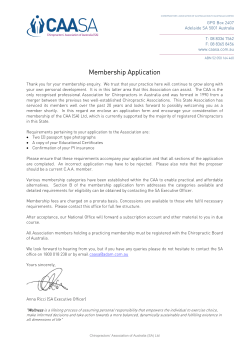
pdf - School of Mathematics
Certified Actuarial Analyst (CAA) – a truly global qualification Trevor Watkins 15 May 2015 Education – Strategic Objective To provide high quality qualifications for our students and lifelong education for our members 2 Overview • Two membership categories (CAA and Student Actuarial Analyst - SAA) and an associated qualification • Developed in response to market demand • Professionalises those working alongside actuaries and in broader financial services • High quality technical skills and the support of a leading professional body • Clearly differentiated from Fellowship and Associateship. • A general qualification, not practice area-specific • CAAs can use the post-nominal letters ‘CAA’ • Stepping stone to further qualifications 3 The qualification • 1 entry test and 5 exam modules - calculations and bookwork • Module 0 taken by non-members • Modules 0-4 delivered locally by Computer Based Assessment – Pearson VUE • Module 5 is a practical exam on spreadsheet modelling, delivered online • Online Professional Awareness Test (OPAT) – by end of first CPD year • Work Based Skills Requirements: Minimum of 1 year covering 3 ‘domains’ • Regulation: Ongoing CPD + Actuaries’ Code + Disciplinary Scheme + Professionalism Training • Typically 2-3 years part time to qualify, although exemptions from Fellowship exams are available The CAA exams in detail Work Based Skills • Expected to demonstrate acquisition of skills in three key areas: – technical application of actuarial skills – professional and ethical – communication • Work experience not required to sit the modules • SAAs need to demonstrate evidence of one year of relevant work experience in an actuarial or other role before qualifying as a CAA • Learning log and sign-off 6 Comparing the CAA and FIA / FFA CAA FIA / FFA Education requirement None A level / degree Number of exams 6 15 Average time 2-3 years 6-7 years Continuing education Yes Yes Regulated by IFoA Yes Yes Qualified actuary No Yes to qualify 7 Why the CAA? Benefits for candidates • Membership of a globally recognised prestigious body • Globally recognised, portable and attainable qualification • Opens up a wide range of financial career options • Sets CAAs apart in a competitive job market • Member benefits such as networking opportunities Why the CAA? Benefits for employers • Business models are increasingly built around a few high level experts supported by a greater number of technically skilled professionals. The CAA provides an opportunity to invest appropriately in staff development • Professionalises staff performing technical and analytical roles working alongside actuaries, which provides additional assurance to clients • Aids staff retention and boosts morale • Helps employers to attract the best employees 9 Why the CAA? Public interest benefits • Brings those in support roles into a regulatory framework, assuring public confidence • Relevant and affordable – Fellowship isn’t always the right choice but is sometimes the only choice • Promotes actuarial science and the value of actuaries • Helps actuarial capacity building in markets where there is a desire for industry growth at pace and at manageable cost (e.g. microinsurance) 10 Who will take the qualification: target audiences Candidates: • Employees working alongside actuaries in technical level support roles • School leavers with strong maths skills who want to learn on the job • University graduates who want a career in finance, perhaps something more broad than traditional actuarial roles • Those on the traditional qualification pathway for whom Fellowship is unsuitable Primary locations: • Africa • Europe • India 11 CAA candidates: registration figures • Take up has been as expected, over 100 registering for M0 for each sitting • Over 250 candidates sitting exams in over 30 countries. Large numbers of bookings from the UK, Africa and India • In Africa, Module 0 entries have come from: Botswana, Ghana, Kenya, Namibia, Nigeria, South Africa, Tanzania, Uganda, Zambia and Zimbabwe • Broad age range of candidates • Interest from those in ‘wider fields’ – IT, data analytics, financial, consulting 12 CAA candidates: case studies Grainne Burke, Ireland “I believe this qualification will help me to move forwards with my career. The technical and communication skills I will gain will enable me to become a more successful analyst and will assist me in taking on a more senior analytical role.” Rohit Verma, India “I’ve always had an interest in Financial Modelling and risk modelling but being from an engineering background I didn't find a good opportunity to test myself in the field. But the CAA gives me a way to learn all those skills and gain knowledge, as well as providing me with membership of one of the most reputed professional bodies.” 13 Support for the CAA • “I can clearly see how the internationally recognised Certified Actuarial Analyst qualification will strengthen the skills needed in my organisation.” Andrew Rear, Chief Executive, Munich Re • “Many of the tasks performed within the organisation are of a technical nature. A designation attached to the work performed will elevate the standing of such work and the trust placed in it.” Stefan Swanepoel, Consulting Actuary, South Africa • Support from: – World Bank – American Academy of Actuaries – Indian Finance Ministry 14 Transfer and exemptions window (1) • The IFoA has opened an exemptions ‘window’ to allow Students with passes in relevant Fellowship exams to gain exemptions from modules on the Actuarial Analyst pathway. Once they have transferred their membership to SAA status, they are able to complete their CAA studies • This option is available until 29 January 2016 • Exemptions generated from passes in Fellowship exams are free • Exemptions from the CAA modules are granted as indicated below: Pass in CT1, CT3, CT4, CT5 or CT6 CT1 CT3 and CT4 CT5 CT6 CA2 OPAT Exemption from Module 0 Module 1 Module 2 Module 3 Module 4 Module 5 OPAT 15 Transfer and exemptions window (2) • An IFoA Fellowship student with passes in CT1, CT3 to CT6 and CA2 can transfer to the membership grade of qualified CAA at any time (subject to meeting the work based skills and professionalism requirements) Can I move from the CAA pathway to the Fellowship pathway? • Passes in any CAA modules do not generate exemptions from the Fellowship exams • A conversion course to enable (fully qualified) CAAs to transfer to the Fellowship pathway will be developed for 2017/18 16 Timescales • Two exam sessions have taken place so far (August 2014 and January 2015) • Registration currently open for third exam session (Modules 0-4), 1-12 June 2015 • Registration will close on 15 May 2015 • Module 5 available quarterly: registration currently open for exam on 2 June 2015 17 Reflections on the CAA • Breadth of interest greater than first anticipated • Demand means we will build a transfer route to Fellowship • Open access – facilitates a move away from the traditional recruitment areas • Completes the IFoA’s suite of qualifications: CAA, Associate, Fellow, plus Chartered Enterprise Risk Actuary (CERA) Questions Comments http://www.actuaries.org.uk/becoming-actuary/caa CAA@actuaries.org.uk 15 May 2015 19 Education Strategy Review Trevor Watkins Background • The last major IFoA review was in 2005 and, although incremental changes have been made since then, the nature of the work of actuaries is changing and we need to reflect these changes to ensure that qualifying actuaries remain fit for purpose in 2025 and beyond • Other actuarial associations are either planning or currently undergoing a strategic review of their qualification process • The IAA is introducing new learning objectives and the IFoA must meet the IAA Core Syllabus standards 21 Why undertake a review? • Ensure actuaries who qualify with the IFoA remain ‘fit for purpose’ over the next ten years • Ensure members of the IFoA are equipped to fulfil wider roles in more diverse areas of work • Maintain the IFoA’s prestigious reputation internationally by ensuring the IFoA’s qualification structure is up-to-date with the current issues facing actuaries world-wide 22 What will the review accomplish? • Ensure content of each subject is cutting edge and relevant to the work of practising actuaries • Removal of less relevant and duplicated material from the syllabi • Balance between technical and softer skills, and between theory and application • Focus on assessing understanding and competence • Appropriate use of information and communication technology (ICT), both within the new syllabus and in the assessment process 23 How will this review be conducted? • Working parties have been set-up to review: – Technical Building Blocks (CT 1, 3-6, 8 and Big Data) – Business Management Skills (CT2, 7 and 9) – Core Application Skills (CA1) – Specialist Building Blocks (ST and SA – Practice Board Consultation) – Practical Experience (Work-based Skills) – CAA Route to Associate 24 Consultation Internal External • Registry team • BPP Actuarial Education (ActEd) • Executive staff • Universities • Education Actuaries • International Associations • Education Board • Employers • Education Committee • Regulators (FRC) • Practice Boards • International Actuarial Association (IAA) • Management Board • Council • IFoA national and international membership • Current volunteers 25 Governance Structure Oversight and approval of logistical decisions Council Oversight and approval of strategic corporate decisions Management Board Oversight and approval of business decisions Education Committee Education Board Workstream members and coordinator Education Strategy Review Working Party Specialists and Executives Working Parties Technical Building Blocks (CT1,3,4-6, 8 & Big Data) Business Management Skills (CT2,7,9) Core Application Skills (CA1) Specialist Building Blocks (ST and SA) Oversight and approval of strategic decisions Oversight and coordination of research and proposals Production of research and proposals Practical Experience (WBS) CAA Route to Associateship 26 Timescales • Phase 1 – Implementation (Jan – Sep 2015) – Review of syllabus content of each subject and initial stakeholder consultation and market research • Phase 2 – Development (Sep 2015 – May 2016) – Changes resulting from the approved proposals are developed and put in place • Phase 3 – Implementation (May 2016 – Apr 2017) – All new material is launched and new processes for updated assessment methods take effect and both become applicable to student members 27 Questions Comments Expressions of individual views by members of the Institute and Faculty of Actuaries and its staff are encouraged. The views expressed in this presentation are those of the presenter. 28
© Copyright 2025









